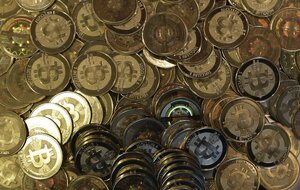Alternative currencies like bitcoin are a mirror of their users
The e-currency bitcoin spiked and then fell last week, sowing doubts about alternative currencies, whether on the Internet or in local communities. Such experiments need a firm basis of trust.

This photo shows bitcoin tokens at software engineer Mike Caldwell's shop in Sandy, Utah. Mr. Caldwell mints physical versions of bitcoins, cranking out homemade tokens with codes protected by tamper-proof holographic seals, a retro-futuristic kind of prepaid cash. With up to 70,000 transactions each day over the past month, bitcoins have been propelled from the world of Internet oddities to the cusp of mainstream use, a remarkable breakthrough for a currency that made its online debut only four years ago.
AP
A big financial story last week was the sudden rise and fall of a new “digital currency” called bitcoin. Designed by computer experts as a form of secure electronic cash backed only by its community of users, bitcoin’s value went from less than $100 to $266 and then back again.
Bitcoin’s bubble-and-burst was not a sign of faith in the future of “cryptocurrencies,” or money systems that assume encrypting software can outsmart a cheating human in e-commerce.
Still, bitcoin, which is the world’s first online decentralized currency, has already spawned better versions of itself (“litecoin” and “PPCoin”). As with other “unofficial” methods of payment, they represent a desire for alternative monetary systems that can be trusted – as well as build trust.
Faith in the global financial system has remained weak since the 2008-09 crisis, especially as central banks from Tokyo to Washington print more money to pump up their economies. Rather than rely on the dollar, the yen, or the euro, many communities – either “virtual” ones on the Internet or real ones on Main Street – are trying alternative currencies.
Some work, some don’t. Their success can depend on the ethical values, social cohesion, and common goals of the community.
“Money does not have value in itself. It’s just paper,” says Jem Bender at Britain’s University of Cumbria and an advocate for new types of exchange systems in trade. “We are the wealth – us – our ability and desire to do things for each other.”
In recent years, attempts to develop local currencies have had a mixed record in places from Ithaca, New York to Toronto. One of the more successful ones is in western Massachusetts, where “Berkshares,” or locally printed bills named after the Berkshire Hills, have been in use since 2006. The well-designed currency helps support local merchants, keeps out “big box” store chains, and strengthens community ties.
One flaw in these home-grown currencies is that they are still tied to a national currency in determining value. Mr. Bender and others hope to break totally free from government money by promoting “credit clearing exchanges.” The practice has been used in Switzerland for decades among thousands of member businesses. Local producers, after all, put most of the value into an economy. Together, they can help set the value in a money exchange.
The “local economy” movement builds on the ideas of a few famous economists, such as the late E.F. Schumacher (“small is beautiful”) and the late Elinor Ostrom, a Nobel Prize winner. Ms. Ostrom is noted for challenging the assumption that humans are inherently selfish, or that they will secretly exploit a shared resource such as a grazing meadow or an ocean fishery. Her study of successful cooperative groups in Nepal, Japan, and elsewhere cast doubt on the long-held theory of “the tragedy of the commons.”
She also pushed for close-knit communities as the basis for a healthy economy, focusing on the quality of relationships more than presuming a selfish pursuit by the individual.
In all their variations, alternative currencies depend on a view of humanity capable of seeking one’s own good in another’s. Currencies are really a measure of how well a community taps into its abundance of trust and confidence – in creating goods and services that are needed and in doing business with honesty.
Golden-rule economics may have a long slog to find the right formula. The bitcoin’s ups and downs show that the experiments in new types of currencies have a long way to go. But money is a great mirror on what a community stands for.

